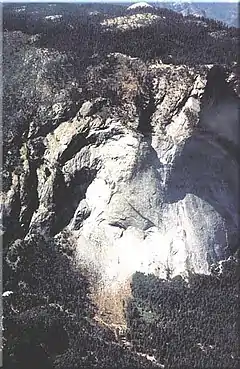1996 Yosemite Valley landslide
The 1996 Yosemite Valley landslide occurred on July 10, 1996, near the Happy Isles trailhead in Yosemite Valley, Yosemite National Park, Mariposa County, California. 162,000 tons of rocks and other debris fell to the ground at over 160 miles per hour. Of the 12 campers/hikers involved in the incident, one was killed. The landslide competes with the 1997 Merced River flood and the 2013 Rim wildfire for the designation of the worst natural disaster in Yosemite to date.
 Aftermath of the landslide | |
| Date | July 10, 1996 |
|---|---|
| Location | Yosemite Valley, YNP, Mariposa County, CA, United States |
| Coordinates | 37.729°N 119.561°W |
| Cause | 162,000 tons of debris fell at speeds of up to 160 mph[1] |
| Deaths | 1 |
Impacts
At 6:52 pm PDT Wednesday, July 10, 1996, a large block of granite, with an estimated volume of 78,000 cubic yards, detached from the cliff between Washburn Point and Glacier Point, in Yosemite Valley.
The first impact occurred at 18:52:28.0 Pacific Daylight Time (02:52:28 UTC), and the second at 18:52:41.6 PDT (02:52:41 UTC).
After detaching from the cliff, the rock mass slide [sic] down a rock shelf for 600 feet at an angle of 50 degrees from vertical and acquired sufficient speed to free-fall ballistically an estimated 1800 feet (550 m) prior to impacting about 200 feet (60 m) from the base of the cliff in the Happy Isles area of the valley floor in Yosemite National Park (field investigation with Gerald Wieczorak and Richard Waitt).
— UC Berkeley Seismograph Station[2]
Effects
One of the impacts killed a hiker near the cliffs.
The force of the impacts was comparable to a 2.15-magnitude earthquake.[2] The impacts also triggered the formation of a massive dust cloud. One witness[3] "noted that the sky went black for six minutes as the dust raised by the cloud blocked out the late afternoon light." The rock fall also caused the uprooting or damage of about 1,000 trees in the immediate blast zone.[3] Structures damaged by the snapping of these trees included the Happy Isles Nature Center, a snack bar, and a bridge.[4] On the day of the incident, the park was hosting as many as 20,000 visitors.[5]
See also
References
- Appalachian Long Distance Hikers Association|ALDHA Landslide at Yosemite
- Robert Uhrhammer (December 10, 1996). "The Yosemite Rock Fall of July 10, 1996". berkeley.edu. Retrieved December 29, 2013.
- Wieczorek, Gerald F.; Snyder, James B.; Waitt, Richard B.; Morrissey, Meghan M.; Uhrhammer, Robert A.; Harp, Edwin L.; Norris, Robert D.; Bursik, Marcus I.; Finewood, Lee G. (2000). "Unusual July 10, 1996, rock fall at Happy Isles, Yosemite National Park, California" (PDF). Geological Society of America Bulletin. 112 (1): 75–85. doi:10.1130/0016-7606(2000)112<0075:ujrfah>2.3.co;2.
- Morrissey M. M. (1999). "Air blasts generated by rockfall impacts: Analysis of the 1996 Happy Isles event in Yosemite National Park". Journal of Geophysical Research: Solid Earth. 104: 23189–23198. Bibcode:1999JGR...10423189M. doi:10.1029/1999JB900189.
- Stephen Schwartz & Teresa Moore (July 11, 1996). "Huge Rock Slide in Yosemite – 1 Killed / Several Injured as slab plunges into Happy Isles area". San Francisco Chronicle. Retrieved December 29, 2013.
